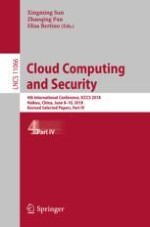2018 | OriginalPaper | Buchkapitel
Adaptive Robust Reversible Watermarking Scheme
verfasst von : Xiang Wang, Tianze Shu, Min Xie, Qingqi Pei
Erschienen in: Cloud Computing and Security
Aktivieren Sie unsere intelligente Suche, um passende Fachinhalte oder Patente zu finden.
Wählen Sie Textabschnitte aus um mit Künstlicher Intelligenz passenden Patente zu finden. powered by
Markieren Sie Textabschnitte, um KI-gestützt weitere passende Inhalte zu finden. powered by
